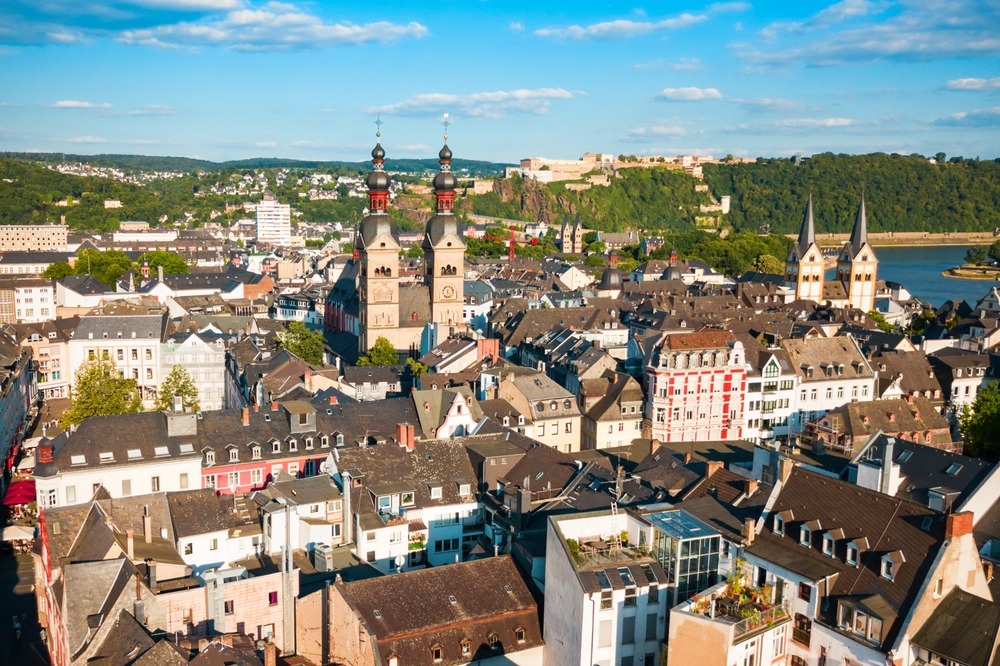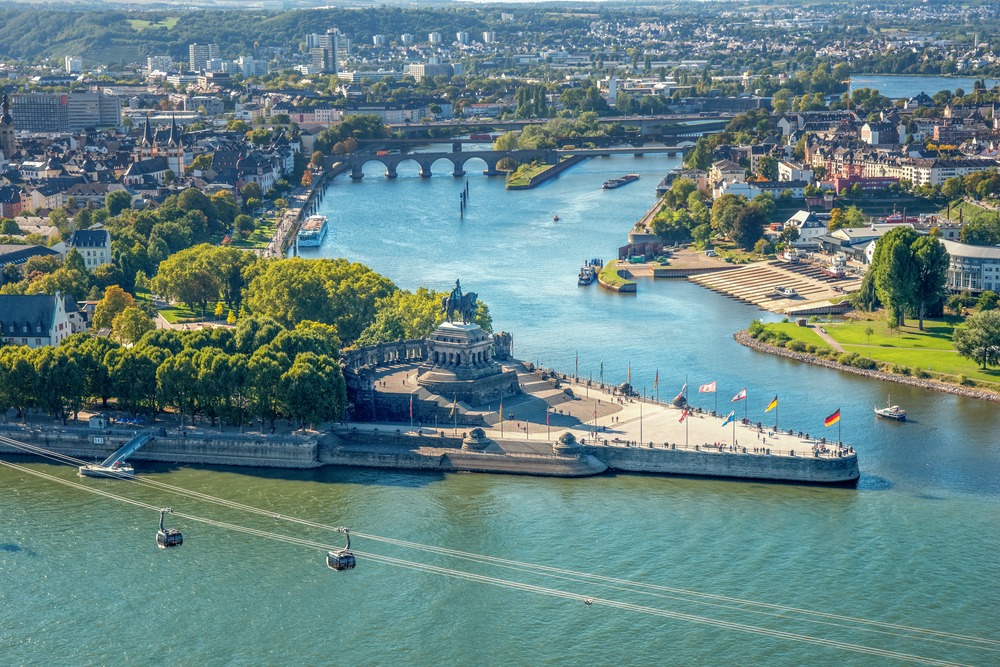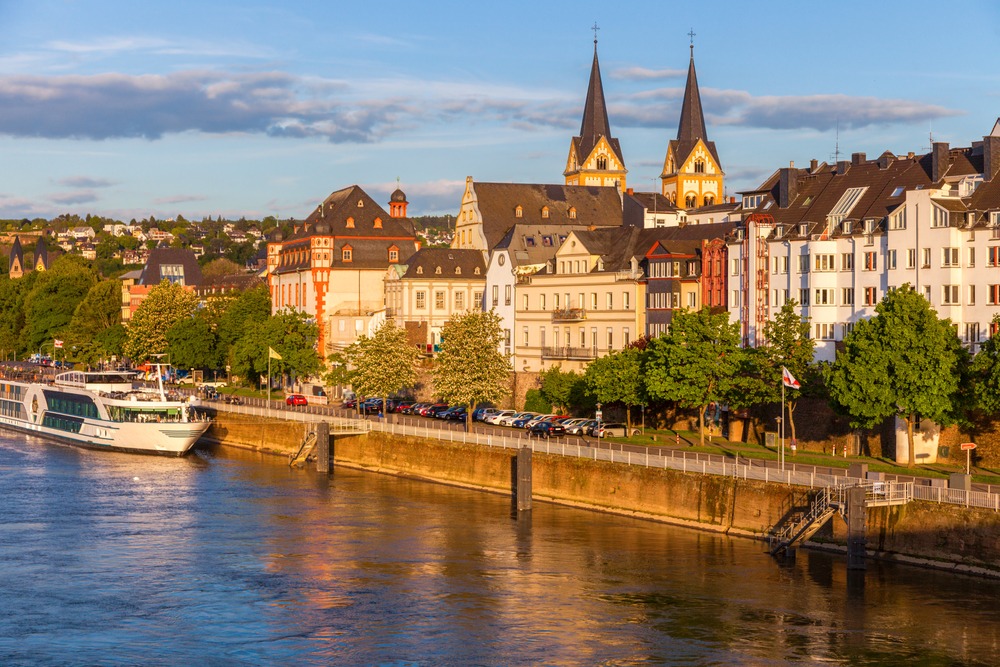Koblenz: Where Rivers Meet and Empires Converge
History of Koblenz – From Roman Outpost to Rhineland Jewel
Koblenz, located at the confluence of the Rhine and Moselle Rivers, is one of the oldest cities in Germany. Its very name reflects its geographical importance—derived from the Latin “Confluentes,” meaning “confluence.” For over two millennia, Koblenz has served as a strategic and symbolic crossroads of cultures, commerce, and conflict.
Founded around 9 BCE as a military post by the Romans under Nero Claudius Drusus, Koblenz was part of the Roman province of Germania Superior. It developed as a key link along the limes (Roman frontier) and was fortified to secure the empire’s borders. The town flourished with Roman roads, bridges, baths, and temples, some remnants of which still linger beneath the city’s layers.

During the Middle Ages, Koblenz came under the control of the Electorate of Trier, a powerful ecclesiastical principality of the Holy Roman Empire. From the 10th to the 18th centuries, Koblenz functioned as an administrative, religious, and cultural center under the rule of the Prince-Electors and Archbishops of Trier. Key developments during this period included the building of the Liebfrauenkirche, the Basilica of St. Castor, and several monasteries and palaces.
In the 18th century, the city experienced the turmoil of European revolutions and wars. It became a refuge for French royalists fleeing the French Revolution, and later fell under French control during the Napoleonic Wars. After Napoleon’s defeat, the Congress of Vienna in 1815 awarded Koblenz to the Kingdom of Prussia. The Prussians transformed the city into a major garrison and administrative hub for the Rhineland, building monumental structures such as the Ehrenbreitstein Fortress and Koblenz Castle.
In the 20th century, Koblenz endured the ravages of two world wars. Heavy bombing during World War II destroyed large parts of the city, but significant historical structures were reconstructed in the post-war years. Following the war, Koblenz became part of the newly founded state of Rhineland-Palatinate, serving for a time as its capital and remaining today a regional administrative center.
Modern Koblenz is a dynamic fusion of ancient and modern. It is celebrated for its Romanesque churches, baroque buildings, Prussian fortifications, and stunning riverscapes. As part of the Upper Middle Rhine Valley, a UNESCO World Heritage Site, Koblenz today stands not just as a gateway to Germany’s romantic riverlands, but also as a living timeline of Western European history.

Top 25 Attractions in Koblenz
1. Deutsches Eck (German Corner)
This iconic headland at the confluence of the Rhine and Moselle is crowned by a monumental equestrian statue of Emperor Wilhelm I. It is a powerful national symbol and offers sweeping river views.
2. Ehrenbreitstein Fortress (Festung Ehrenbreitstein)
Soaring high above the Rhine, this mighty Prussian fortress is the second largest preserved fortress in Europe. Visitors can reach it by cable car and explore museums, historic ramparts, and event spaces within its walls.
3. Koblenz Cable Car (Seilbahn Koblenz)
Connecting the city center to Ehrenbreitstein Fortress, the cable car glides above the Rhine and offers spectacular panoramic views of Koblenz, the rivers, and surrounding vineyards.
4. Basilica of St. Castor (Basilika St. Kastor)
Founded in 836, this Romanesque basilica is Koblenz’s oldest church and historically significant as the site of diplomatic negotiations in the Carolingian era. Its cloistered courtyard and medieval frescoes are a must-see.
5. Koblenz Old Town (Altstadt)
A charming mix of cobbled streets, quaint squares, half-timbered houses, and lively cafes, the Old Town is the city’s cultural heart. Key landmarks include the Church of Our Lady and the Münzplatz.
6. Electoral Palace (Kurfürstliches Schloss)
Built between 1777–1793 in neoclassical style for the last Elector of Trier, this riverside palace later served as a Prussian royal residence. Its elegant gardens and imposing façade offer a taste of Enlightenment-era grandeur.
7. Church of Our Lady (Liebfrauenkirche)
This double-towered Romanesque-Gothic church sits atop the highest point of the Old Town and boasts beautifully preserved stained glass and a peaceful, reflective atmosphere.
8. Görresplatz and Historiensäule
This central square features the 10-meter-high Historiensäule (History Column), a modern sculpture that depicts 2,000 years of Koblenz’s history in a spiraling bronze narrative.
9. Schängel Fountain (Schängelbrunnen)
Located in the courtyard of the Town Hall, this playful fountain of a mischievous boy periodically spits water on unsuspecting visitors, celebrating the city’s humorous mascot, the “Schängel.”
10. Ludwig Museum in the Deutschherrenhaus
Situated in a medieval Teutonic Order building at the Deutsches Eck, this contemporary art museum focuses on Franco-German relations and features rotating exhibitions from the Ludwig Collection.
11. Jesuitenplatz
A picturesque square in the Old Town, framed by the former Jesuit College and Church, now serving as the City Hall. It’s a great place for a relaxed meal or coffee with historic ambiance.
12. Rheinpromenade (Rhine Promenade)
This tree-lined riverside walk is perfect for relaxing strolls, cycling, or river watching. It connects many of the city’s major sights and offers lush parks and scenic photo opportunities.
13. Museum of the Middle Rhine (Mittelrhein-Museum)
Located in the Forum Confluentes cultural center, this museum explores regional history, art, and culture from the Middle Ages to the modern period.
14. Romanticum
Also in Forum Confluentes, this interactive experience immerses visitors in the myths, legends, and scenic beauty of the Rhine Valley. Ideal for families and first-time visitors.
15. Forum Confluentes
A modern architectural centerpiece of the city, it houses several museums, the city library, and a tourist information center, blending history with contemporary design.
16. Stolzenfels Castle (Schloss Stolzenfels)
Located just south of Koblenz, this 19th-century neo-Gothic castle was built by King Friedrich Wilhelm IV of Prussia as a romantic retreat. Its hilltop setting offers panoramic views of the Rhine and lavish royal interiors.
17. Pfaffendorf Bridge (Pfaffendorfer Brücke)
One of the main bridges spanning the Rhine, it offers access to Ehrenbreitstein and spectacular views, particularly at sunset.
18. Königsbacher Brewery Ruins and Gardens
Although brewing operations have ceased, this historic riverside site near Ehrenbreitstein includes gardens and seasonal events in a rustic setting.
19. Fort Asterstein
A smaller 19th-century Prussian fortification located near the Ehrenbreitstein complex, now partially in ruins but open for exploration and offering great views.
20. Weindorf Koblenz (Wine Village)
This riverside complex mimics a traditional wine village and offers wine tastings, local cuisine, and charming views—especially popular during the Koblenz Wine Festival.
21. Balduin Bridge (Balduinbrücke)
Built in the 14th century, this is the oldest bridge in Koblenz and a fine example of medieval engineering. It connects the Old Town with the Lützel district.
22. Florinsmarkt and the Old Department Store (Altes Kaufhaus)
This square features several historic buildings, including the Florinskirche and the Old Department Store with its baroque façade and astronomical clock.
23. Koblenz Puppet Theater (Koblenzer Puppenspiele)
A delightfully whimsical venue that hosts traditional puppet shows with masterful craftsmanship, suitable for both children and adults.
24. Koblenz Christmas Market (Weihnachtsmarkt Koblenz)
Held annually in the Old Town, this festive market fills squares with lights, music, and the aroma of mulled wine and gingerbread. It’s one of the region’s most beloved holiday events.
25. Rhine in Flames (Rhein in Flammen)
A spectacular annual summer event featuring fireworks, illuminated boats, and riverside festivals along the Rhine, with Koblenz as one of the main stages.

Koblenz is more than just a point on a map—it’s a city where history, landscape, and culture converge. From its Roman foundations to its role in the Holy Roman and Prussian empires, from sacred churches to fortresses built into cliffs, Koblenz offers layers of European civilization that unfold along the winding banks of the Rhine and Moselle. Visitors will find themselves immersed not only in centuries of human endeavor, but also in the beauty and rhythms of the rivers that have shaped it all. Whether wandering its medieval streets or gazing from its mountaintop fortresses, Koblenz leaves an indelible impression as one of Germany’s most storied and scenic destinations.

































